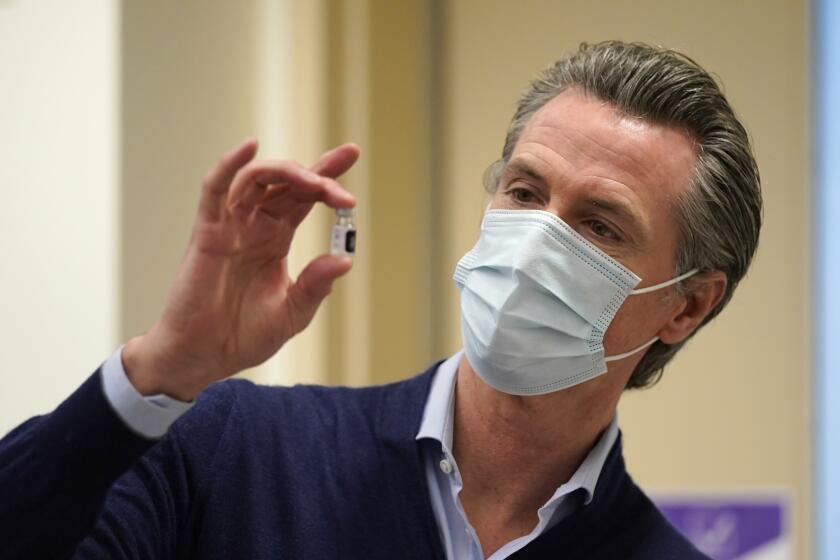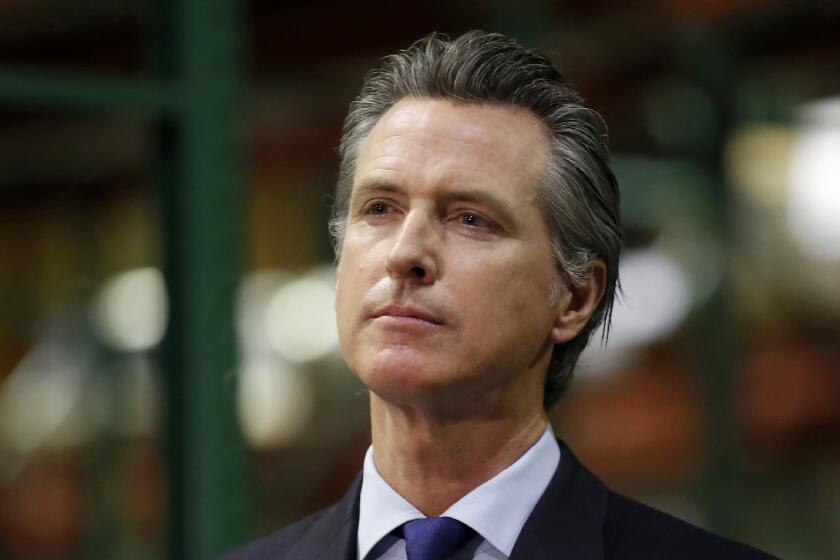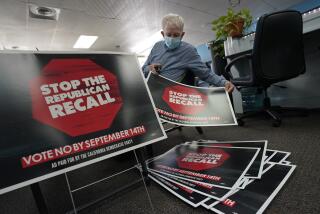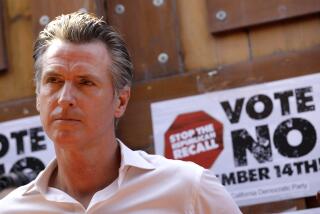Newsom recall effort moves closer toward making the ballot, submitting 1.1 million signatures
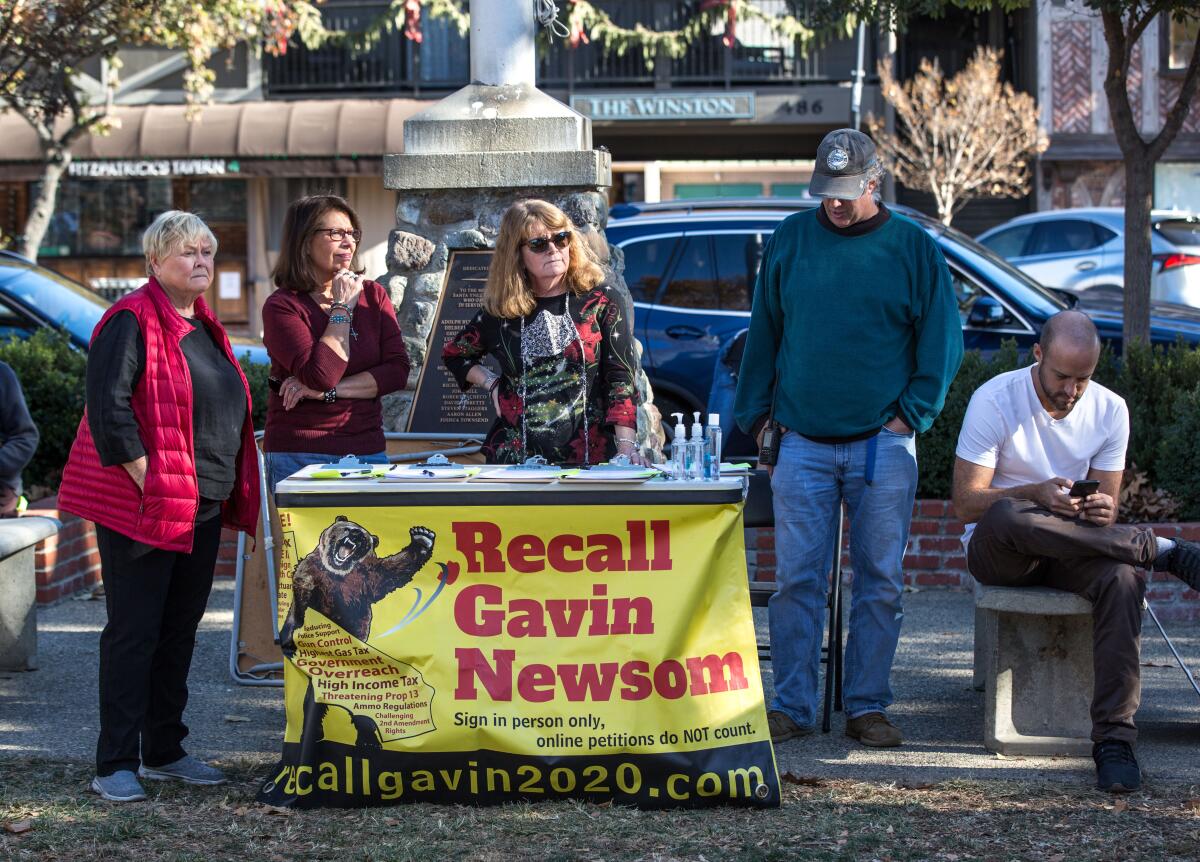
- Share via
SACRAMENTO — Almost 1.1 million signatures have been submitted in support of a recall election against Gov. Gavin Newsom, state elections officials reported Friday, though supporters said a sizable number of voter petitions have yet to be reviewed as the effort approaches next month’s official deadline.
The tally released by Secretary of State Shirley Weber shows that 1,094,457 signatures had been turned in as of Feb. 5, with 668,202 confirmed as valid. The majority of signatures that remained — more than 296,000 — had not yet been reviewed by elections officials in California’s 58 counties, making it difficult to fully assess the likelihood of a special statewide election later this year. An additional 130,108 signatures were deemed invalid during the review process.
One factor in favor of recall backers is the relatively low rate of rejected signatures. Only about 16% of those that have been checked for accuracy were rejected, significantly better than most ballot measure campaigns in recent years.
“We’ve crossed some big hurdles,” said Orrin Heatlie, the official proponent of the recall effort. “We aren’t stopping.”
The groups seeking to remove Newsom from office, with Heatlie’s organization coordinating the effort, must submit 1,495,709 valid voter signatures by March 17 to trigger a recall election. Similar to the process of qualifying a statewide ballot measure, backers are gathering more signatures than needed as a buffer for any that are rejected because of unverifiable or inaccurate information.
Because signatures must be submitted to elections officials in the county where the voter lives, the process can be difficult to track in real time. And it might be slower than usual, as a number of county government offices are operating under COVID-19 workplace rules that seek to limit employee exposure. Counties have until April 29 to finish their verification of recall signatures, which could mean a potential recall election wouldn’t be held until early November.
As a snapshot in time, the report issued by Weber could fail to fully capture the political risk faced by the Democratic governor, under fire over his efforts to address the COVID-19 pandemic by what recent polls have shown is a growing cross section of Californians.
“People have just completely lost confidence in his ability to lead,” said Heatlie, a retired sheriff’s deputy in Yolo County. “They’re frustrated with him.”
Even so, voters may need to be convinced that frustration is sufficient reason to remove Newsom before his term ends in January 2023. In a poll released earlier this month by the UC Berkeley Institute of Governmental Studies, only 36% of voters said they would vote to remove Newsom if the recall qualified for the ballot.
Newsom approval plummeting with a third of voters support recall amid COVID-19 criticism, poll finds
More than a third of the state’s registered voters said they would vote to oust Newsom from office if the recall qualified for the ballot, though 45% said they would oppose such a move, a Berkeley IGS poll found.
Heatlie said the campaign has collected some 1.7 million signatures to date, with almost 1.3 million submitted to elections officials — though not all of those were delivered in time to be included in the report released Friday.
The threshold for qualifying a recall petition — enough signatures to equal 12% of the votes cast in the last gubernatorial election — is set in state law. If successful, it would fall to Lt. Gov. Eleni Kounalakis to schedule the election, no later than 80 days after certification by Weber. A number of other steps are built into the elaborate process, including reviews of the election cost by state finance officials and the Legislature, and a 30-day window in which voters who signed the recall petition can ask to have their signatures withdrawn if they’ve changed their mind.
Dan Newman, a campaign spokesman for Newsom, said the recall is not what voters want to think about in the coming weeks and months.
“Californians want to stay focused on vaccinations, reopenings, relief and recovery — without the distraction and expense of a $100 million, hyperpartisan Republican recall circus,” he said in a statement.
While every California governor since 1960 has faced one or multiple petitions seeking his ouster, the campaign waged against Newsom is the most far-reaching and successful of any such movement since 2003, when voters recalled then-Gov. Gray Davis nine months into his second term in office. The Democratic incumbent was replaced by Republican Arnold Schwarzenegger, the top vote-getter in a field of 135 hopefuls whose names were listed on the second part of the recall ballot.
Like the campaign against Davis, the Newsom recall effort has been fueled largely by Republican activists and donors. Several prominent donors to GOP campaigns and candidates contributed cash to help collect voter signatures. Prior to their involvement, though, the campaign relied primarily on volunteers. In some cases, the most visible and vocal supporters of the effort were activists aligned with far-right causes that simultaneously promoted extremist views and QAnon conspiracy theories.
Conceived by fierce partisanship, the recall campaign against Gov. Gavin Newsom will hinge on his leadership.
As the recall campaign has grown, mainstream Republican groups have taken up the cause. The California Republican Party supports the campaign and two high-profile GOP hopefuls — former San Diego Mayor Kevin Faulconer and 2018 candidate John Cox — have announced they intend to run as replacement candidates if the recall qualifies.
Perhaps no decision has benefitted the recall supporters more than a Nov. 17 ruling by a Sacramento County Superior Court judge that extended the signature-gathering period an additional four months due to COVID-19 restrictions that supporters said had hampered their efforts.
Only three governors in U.S. history have ever faced a recall election, the most recent in 2012 when Wisconsin voters rejected the effort to unseat then-Gov. Scott Walker, a Republican.
Should the Newsom recall effort qualify for the ballot, one feature of the election will be unique to the pandemic era. On Friday, the governor signed legislation extending last year’s election rules — requiring that every registered voter be mailed a ballot — for all special elections held in 2021. The bill was prompted by a pair of vacancies in the Legislature, but its provisions would also apply to a statewide recall election.
More to Read
Sign up for Essential California
The most important California stories and recommendations in your inbox every morning.
You may occasionally receive promotional content from the Los Angeles Times.
